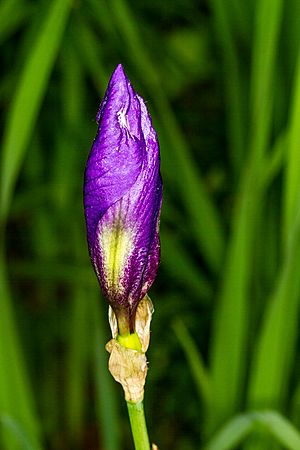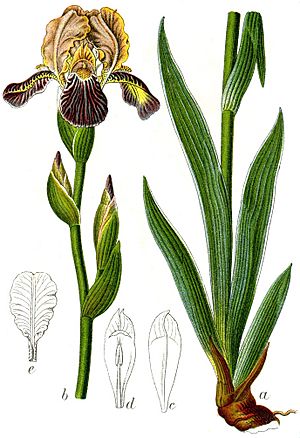Elder scented iris facts for kids
Quick facts for kids Elder scented iris |
|
|---|---|
 |
|
| Iris sambucina flower in bud | |
| Scientific classification | |
| Genus: |
Iris
|
| Species: |
sambucina
|
| Synonyms | |
|
|
The Elder Scented Iris, or Iris sambucina, is a beautiful flower from the Iris family. It grows from a thick underground stem called a rhizome. This plant is a perennial, meaning it lives for more than two years. You can find it in parts of southern and central Europe, including Germany, Britain, Ireland, Italy, the Balkans, Croatia, and Spain.
This iris has green, sword-shaped leaves and tall stems with branches. Its large flowers come in many shades of purple, from brownish-purple to blue-violet. They smell like elderflowers, which is how it got its name! People sometimes grow this iris in their gardens because it's so pretty. Scientists believe it might be a natural hybrid, meaning it's a mix of two other iris species: Iris pallida and Iris variegata.
Contents
Discover the Elder Scented Iris
The Elder Scented Iris looks a lot like Iris germanica, but its flowers are usually darker and have a lovely scent.
What Does the Iris Look Like?
This iris has thick, fleshy rhizomes that spread out. Its leaves are green, sword-shaped, and can curve. They can grow up to 20–80 cm (8–31 in) long and 1.3 to 2.5 cm wide. The leaves also have a strong elder scent.
The plant has a round stem, called a peduncle, which can grow between 40–100 cm (16–39 in) tall. This stem is usually taller than the leaves and often has branches. Each stem has large, leaf-like structures called spathes that protect the flower bud. They are green at the bottom and thin, like paper, at the top.
The stems and branches hold two or more flowers. These flowers bloom in summer, usually from April or May to June.
The Beautiful Flowers
The large flowers are about 4–7 cm (2–3 in) long. They smell like elderflowers and come in many shades of violet. You might see them in brown-violet, brown-purple, purple-violet, blue-violet, mauve, or even pure purple. Their colors can change depending on where they grow.
Like other irises, this plant has two pairs of petals. There are three large outer petals called 'falls' and three smaller inner petals called 'standards'. The falls hang downwards and are shaped like a spoon. They can be brownish-purple with yellow-white veins. In the middle of each fall, there's a row of short, yellow or orange hairs called the 'beard'.
The standards stand upright and are oval-shaped. Their tips often lean towards each other, and their edges can be jagged.
After flowering, most irises produce a seed pod. However, because Iris sambucina is a hybrid, it usually does not develop seeds.
How Scientists Study Irises
Scientists study the number of chromosomes in plants to understand how different species are related. Most irises have two sets of chromosomes, which is called being diploid. Iris sambucina has been found to have 24 or 40 chromosomes.
For example, Iris germanica has 44 or 48 chromosomes, while Iris variegata has 24. This suggests that Iris variegata is more likely to be one of the parent species of Iris sambucina.
Naming the Elder Scented Iris
This iris is commonly known as the 'elder scented iris' or 'Iris elderflower'. In Swedish, it's called 'fläderiris', and in Germany, it's known as 'holunder schwertlilie', which means 'elderberry iris'.
The Latin name sambucina comes from the word Sambucus, which is the scientific name for the elder plant. This name was chosen because the flowers smell like elderflowers.
The famous scientist Carl Linnaeus first described and named this plant in his book Systema Naturae in 1759.
Over time, some scientists thought Iris sambucina was a separate species, while others thought it was just a type of Iris germanica. Today, many experts, including the RHS, consider Iris sambucina to be a distinct species, but one that likely came from a mix of Iris variegata and Iris pallida.
Where the Elder Scented Iris Grows
This iris is native to southern and central Europe.
Places It Calls Home
You can find Iris sambucina in countries like Germany, Britain, Ireland, Italy, the Balkans (which used to be Yugoslavia), and Spain.
Where It Likes to Live
The Elder Scented Iris loves sunny, well-drained places. It grows on rocky slopes, in mountain meadows, and even on the walls of old castles. In the South Tyrol region of Italy, these plants can be found as high as 950 m (3,120 ft) above sea level.
Growing Elder Scented Irises
This iris is quite tough and can survive in many climates. It can handle cold temperatures down to about −39.9 °C (−40 °F) and warmer temperatures up to −9.4 °C (15 °F).
It prefers to grow in calcareous (lime-rich), well-drained, or rich soils, and it needs full sun.
People often grow this iris in their gardens. It looks great in flower borders, at the edges of shrub areas, or growing wild in a garden. It was first brought to Britain in 1658. While it's not always easy to find in plant nurseries, some German nurseries do sell different types of this iris.
Be aware that slugs can sometimes attack these plants.
How to Grow More Irises
Since Iris sambucina is a hybrid and usually doesn't produce seeds, the best way to grow more plants is by dividing its rhizomes. This means carefully splitting the underground stems into smaller pieces, each with roots and leaves, and replanting them.
Different Types of Elder Scented Irises
This iris can create new hybrids with flowers that mix yellow, red, and brown colors. Some known types, called cultivars, include 'Gypsy Queen', 'Leopold', 'Mägdeberg', and 'President Lincoln'.
Important Safety Information
Like many other irises, most parts of the Iris sambucina plant are poisonous, especially the rhizome and leaves. If someone accidentally eats them, it can cause stomach pains and vomiting. Handling the plant might also cause skin irritation or an allergic reaction for some people. It's always best to be careful and wash your hands after touching plants.
Images for kids



